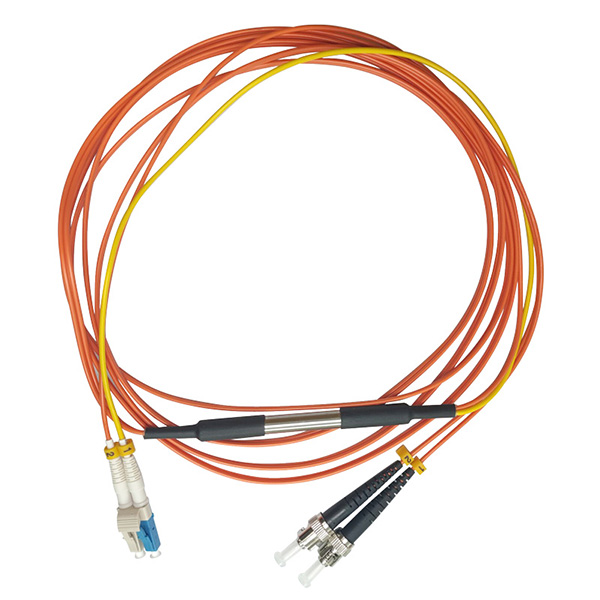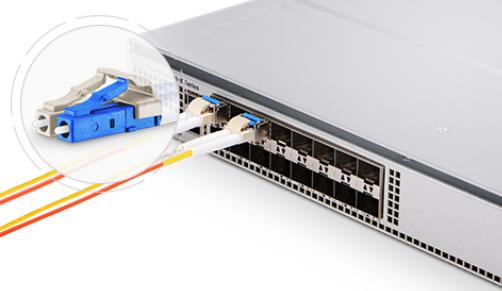La grande richiesta di una maggiore larghezza di banda ha portato al rilascio dello standard 802.3z (IEEE) per Gigabit Ethernet su fibra ottica.Come tutti sappiamo, i moduli ricetrasmettitori 1000BASE-LX possono funzionare solo su fibre monomodali.Tuttavia, ciò può rappresentare un problema se una rete in fibra esistente utilizza fibre multimodali.Quando una fibra monomodale viene lanciata in una fibra multimodale, apparirà un fenomeno noto come Differential Mode Delay (DMD).Questo effetto può causare la generazione di più segnali che possono confondere il ricevitore e produrre errori.Per risolvere questo problema, è necessario un cavo patch di condizionamento della modalità.In questo articolo, alcune conoscenze dicavi patch di condizionamento della modalitàsarà introdotto.
Che cos'è un cavo patch di condizionamento della modalità?
Un cavo patch di condizionamento della modalità è un cavo multimodale duplex che ha una piccola lunghezza di fibra monomodale all'inizio della lunghezza di trasmissione.Il principio di base alla base del cavo è che si lancia il laser nella piccola sezione della fibra monomodale, quindi l'altra estremità della fibra monomodale viene accoppiata alla sezione multimodale del cavo con il nucleo sfalsato dal centro della fibra multimodale fibra.
Come mostrato nella foto

Questo punto di offset crea un lancio simile ai tipici lanci LED multimodali.Utilizzando un offset tra la fibra monomodale e la fibra multimodale, i cavi patch di condizionamento della modalità eliminano il DMD ei risultanti segnali multipli consentendo l'uso di 1000BASE-LX sui sistemi di cavi in fibra multimodali esistenti.Pertanto, questi cavi patch di condizionamento della modalità consentono ai clienti un aggiornamento della loro tecnologia hardware senza il costoso aggiornamento del loro impianto in fibra.
Alcuni suggerimenti quando si utilizza il cavo patch di condizionamento della modalità
Dopo aver appreso una certa conoscenza dei cavi patch di condizionamento della modalità, ma sai come usarlo?Quindi verranno presentati alcuni suggerimenti sull'utilizzo dei cavi di condizionamento della modalità.
I cavi patch di condizionamento della modalità vengono solitamente utilizzati in coppia.Ciò significa che sarà necessario un cavo patch di condizionamento della modalità a ciascuna estremità per collegare l'apparecchiatura all'impianto di cablaggio.Quindi questi cavi patch sono solitamente ordinati in numero.Potresti vedere qualcuno ordinare solo un cavo patch, quindi di solito è perché lo tiene come scorta.
Se il modulo ricetrasmettitore 1000BASE-LX è dotato di connettori SC o LC, accertarsi di collegare la parte gialla (modalità singola) del cavo al lato di trasmissione e la parte arancione (multimodale) al lato di ricezione dell'apparecchiatura .Lo scambio di trasmissione e ricezione può essere effettuato solo sul lato dell'impianto di cablaggio.
I cavi patch di condizionamento della modalità possono convertire solo la modalità singola in modalità multimodale.Se si desidera convertire la modalità multimodale in modalità singola, sarà necessario un convertitore multimediale.
Inoltre, i cavi patch di condizionamento della modalità vengono utilizzati nella finestra di lunghezza d'onda ottica di 1300 nm o 1310 nm e non devono essere utilizzati per la finestra di lunghezza d'onda corta di 850 nm come 1000Base-SX.

Conclusione
Dal testo, sappiamo che i cavi patch di condizionamento della modalità migliorano notevolmente la qualità del segnale dati e aumentano la distanza di trasmissione.Ma quando lo si utilizza, ci sono anche alcuni suggerimenti da tenere a mente.RAISEFIBER offre cavi patch di condizionamento in tutte le varietà e combinazioni di connettori in fibra ottica SC, ST, MT-RJ e LC.Tutti i cavi patch di condizionamento in modalità RAISEFIBER sono di alta qualità e a basso prezzo.
Orario di pubblicazione: 03-set-2021

